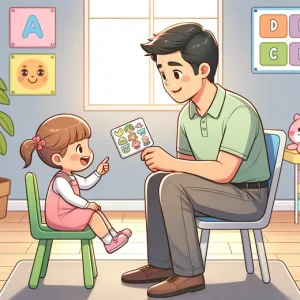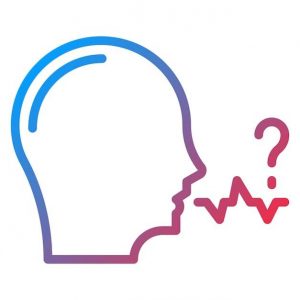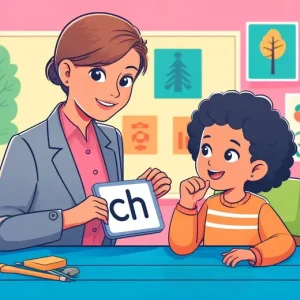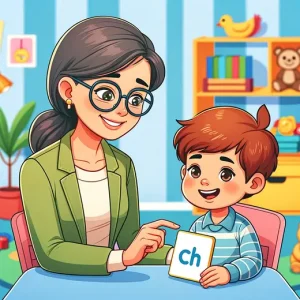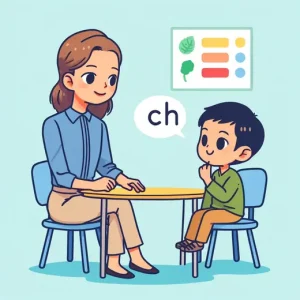ADHD and Autism: Similarities and Differences
By Rajini D
Last Updated: January 31, 2024
In a world where understanding and embracing neurodiversity is becoming increasingly important, two neurodevelopmental disorders often discussed are Attention Deficit Hyperactivity Disorder (ADHD) and Autism Spectrum Disorder (ASD). While these conditions are distinct, their overlapping symptoms often lead to confusion and misdiagnosis. ADHD, known for its hallmark symptoms of inattention, hyperactivity, and impulsivity, affects individuals across various stages of life. On the other hand, Autism, a multifaceted spectrum disorder, primarily impacts social interactions and communication skills.
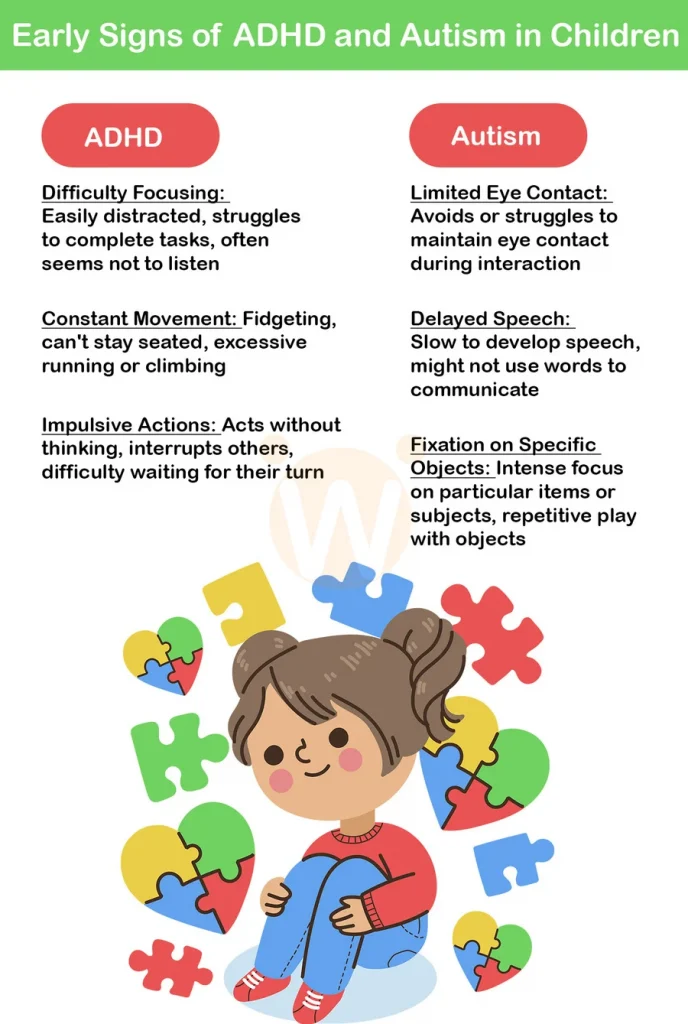
For an introductory understanding of mental health issues in students, which can sometimes overlap with ADHD and Autism, see our article Mental Issues Students Face.
Understanding ADHD (Attention Deficit Hyperactivity Disorder)
As we delve further into the realm of neurodevelopmental disorders, let’s focus on Attention Deficit Hyperactivity Disorder (ADHD), a condition often mentioned in discussions surrounding child development and learning challenges. ADHD is not just a childhood issue; it spans a lifetime, affecting about 5% of children and 2.5% of adults worldwide.
For more insights into how ADHD affects adults, see our article on Adult ADHD
ADHD manifests primarily in three forms:
- Inattentive Type: This subtype is often less visible than its hyperactive counterpart. Individuals with inattentive ADHD might seem daydreamy or absent-minded. They struggle with maintaining focus, organizing tasks, and following through with instructions. This can be misconstrued as a lack of interest or carelessness, but it’s important to recognize that these are symptoms of a neurodevelopmental disorder, not personality traits.
- Hyperactive-Impulsive Type: Those with this form of ADHD are often on the move, exhibit restless behaviors, and act impulsively. They may find it challenging to sit still for extended periods, which can be particularly noticeable in classroom or work settings. Their impulsive nature can lead to interrupting conversations or acting without considering the consequences.
- Combined Type: As the name suggests, this type includes symptoms of both inattention and hyperactivity-impulsivity. It’s the most common form of ADHD and can be particularly challenging as it combines the difficulties of both other types.
Individuals with ADHD face various challenges in their daily lives. For children, ADHD can make classroom learning and social interactions tough. They might have trouble keeping up with lessons or maintaining friendships due to misunderstood behaviors. Adults with ADHD often struggle with organizational skills, time management, and maintaining focus in their professional and personal lives. These challenges can lead to feelings of frustration, low self-esteem, and sometimes, misunderstood intentions.
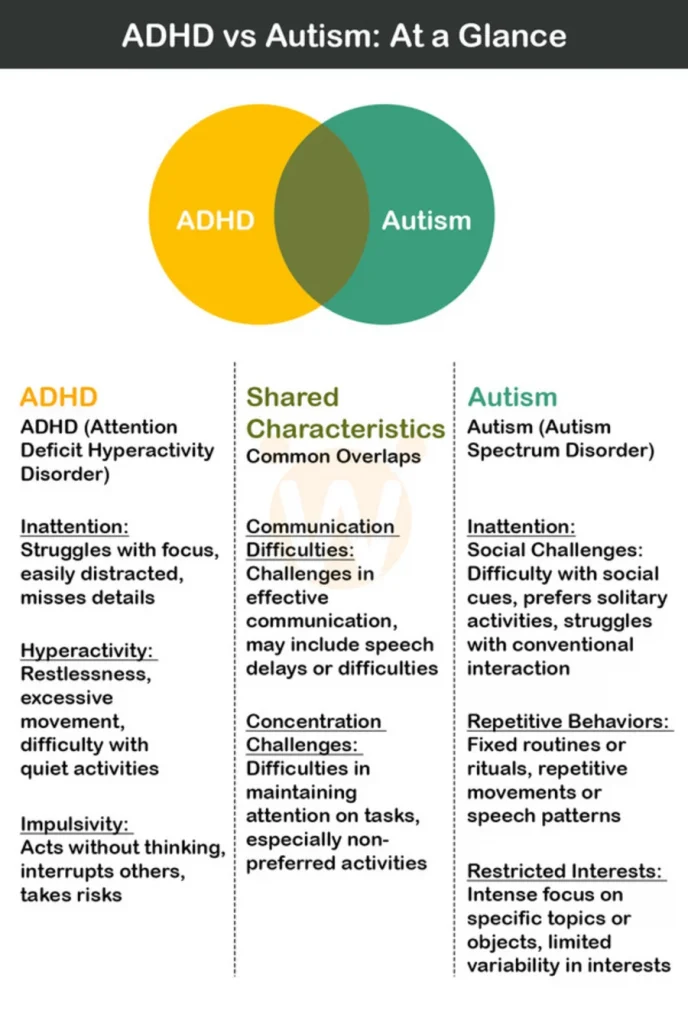
Exploring Autism Spectrum Disorder (ASD)
Autism Spectrum Disorder (ASD), as the name suggests, is a broad range of conditions characterized by challenges with social skills, repetitive behaviors, speech, and nonverbal communication. It’s called a ‘spectrum’ because there’s a wide variation in the type and severity of symptoms people experience. ASD occurs in all ethnic, racial, and economic groups. Although ASD can be a lifelong disorder, treatments and services can improve a person’s symptoms and ability to function.
Explore our detailed piece on Autism and Language Development for a deeper understanding of communication challenges.
The key characteristics of ASD include:
- Social Communication and Interaction Challenges: This is one of the most noticeable signs of ASD. Individuals with Autism might struggle with understanding or using non-verbal communication, such as eye contact, facial expressions, and gestures. They might find it difficult to build friendships appropriate to their age level, share interests with others, or understand the give-and-take of conversation.
- Repetitive Behaviors and Restricted Interests: People with ASD may repeat certain behaviors or have unusual behaviors. For example, they might repeat a phrase or sound, have a lasting intense interest in specific topics, or focus on certain aspects of objects (like the wheels of a toy car). They may also thrive on routine or have specific rituals.
- Debunking Misconceptions About Autism: It’s crucial to dispel some common myths about Autism. For instance, not all individuals with Autism are savants or have extraordinary talents, as often portrayed in media. Autism doesn’t always imply an intellectual disability – in fact, many people with Autism have average or above-average intelligence. Additionally, while social interactions can be challenging, this doesn’t mean that people with Autism don’t desire friendships or relationships.
For more on the challenges of Autism in early childhood, refer to Early Identification Warning Signs in Child Development.
Similarities Between ADHD and Autism
While ADHD (Attention Deficit Hyperactivity Disorder) and Autism Spectrum Disorder (ASD) are distinct neurodevelopmental disorders, they do share some common ground, leading to overlaps in symptoms and challenges. Understanding these similarities is crucial, not only for accurate diagnosis but also for developing effective support strategies.
Also Read: Parenting Styles | Child Psychology
Overlapping Symptoms in Communication and Concentration:
Both ADHD and Autism can present challenges in communication. For individuals with ADHD, these may manifest as difficulty in staying on topic, interrupting conversations, or not paying attention to social cues. In contrast, those with Autism might struggle with understanding non-verbal communication, initiating interactions, or responding appropriately in conversations. Furthermore, concentration issues are common in both disorders. A child with ADHD may have trouble focusing on tasks that don’t interest them, while a child with Autism may focus intensely on specific interests but struggle to concentrate on broader topics.
Challenges in Social Interactions:
Social interactions can be a hurdle for both individuals with ADHD and those with Autism. While the root causes differ — impulsivity and inattention in ADHD and challenges with social cues and non-verbal communication in Autism — the outcome is often the same: difficulties in forming and maintaining relationships. These challenges can sometimes lead to social isolation or misunderstanding in social settings, underscoring the importance of empathy and support from those around them.
The Significance of Early and Accurate Diagnosis:
Recognizing the similarities between ADHD and Autism is important for early and accurate diagnosis. Misdiagnosis or delayed diagnosis can lead to ineffective treatments and increased frustration for both the individual and their families. Early intervention and tailored support strategies can significantly improve quality of life, help in the development of social skills, and support academic and occupational achievements.
In discussing the social challenges of both disorders, link to “How to Build Great Work Relationships” for insights on managing social interactions in adult life.
Distinguishing ADHD and Autism
While ADHD (Attention Deficit Hyperactivity Disorder) and Autism Spectrum Disorder (ASD) share certain similarities, understanding their distinctive features is crucial for accurate diagnosis and effective management. Let’s delve into a detailed comparison of specific symptoms and behaviors that set these two neurodevelopmental disorders apart.
Also Read: The Effect of Colors in Autistic Children | Color Preferences in Children with Autism
Behavioral Characteristics: ADHD vs Autism
| Characteristic | ADHD | Autism |
|---|---|---|
| Focus on Tasks | Difficulty sustaining attention on non-preferred tasks. Often easily distracted. | Intense focus on areas of interest, often to the exclusion of other activities. May ignore other tasks. |
| Social Interaction | May interrupt conversations or struggle with turn-taking. Impulsive responses in social settings. | Challenges in understanding and responding to social cues. May prefer solitude or struggle with conventional social interaction. |
| Communication Style | Often impulsive in speech, may speak without thinking. Can have trouble listening in conversations. | May exhibit limited or repetitive speech patterns. Difficulties in using and understanding non-verbal cues like gestures and facial expressions. |
| Behavioral Patterns | Fidgety and often unable to stay still. May show behaviors like tapping or restless movement. | Preference for routines and consistency. Can become upset or distressed with changes in routine or environment. |
| Response to Sensory Input | Responses to sensory input can vary widely. Some may have sensitivities, but it’s not a defining characteristic of ADHD. | Often, they have heightened or reduced sensitivity to sensory input such as sounds, textures, and lights. Sensory preferences and aversions are common. |
Differences in Attention Span:
A key differentiator between ADHD and Autism lies in their attention spans. Individuals with ADHD often display an inconsistent attention span. They might find it difficult to focus on tasks that aren’t immediately engaging or are routine. In contrast, people with Autism may show intense focus on subjects that interest them, sometimes to the exclusion of everything else. This focused attention can be so absorbing that it might be challenging to shift their attention to other tasks or activities.
Communication Styles:
The way individuals with ADHD and Autism communicate can be quite different. Those with ADHD may talk excessively, interrupt others, and struggle with listening in conversations due to their impulsivity and hyperactivity. In contrast, individuals with Autism might have difficulties with both verbal and non-verbal communication. They might not use or understand gestures, have limited eye contact, and may not pick up on social cues. Their speech patterns could include repetitive or rigid language and difficulty in back-and-forth conversation.
Approach to Routines:
People with ADHD generally have a hard time with routines. They often seek novelty and can become easily bored with repetitive tasks. This can manifest in an aversion to structured routines and a tendency to procrastinate. On the other hand, individuals with Autism often find comfort and security in routines. They may become distressed with changes in their environment or daily schedule and prefer predictability and structured patterns in their daily life.
Sensory Processing and Executive Function:
Both ADHD and Autism involve challenges with sensory processing and executive function, but these manifest differently. Individuals with ADHD may have difficulties with executive functions like organizing, planning, and prioritizing, which affects their ability to manage daily tasks. On the other hand, individuals with Autism might have heightened or reduced sensitivity to sensory inputs, such as sound, light, and touch, and may have particular preferences or aversions in their environment.
Co-occurrence of ADHD and Autism
The intersection of ADHD (Attention Deficit Hyperactivity Disorder) and Autism Spectrum Disorder (ASD) presents a unique set of challenges and considerations. It’s not uncommon for an individual to be diagnosed with both conditions, a phenomenon known as comorbidity. Understanding the co-occurrence of ADHD and Autism is crucial for providing appropriate care and support.
Also Read: Engaging Home-Based Occupational Therapy Activities for Children with Autism
Exploring the Possibility and Implications:
When ADHD and Autism co-exist in an individual, it can complicate diagnosis and treatment. The overlapping symptoms may intensify, leading to increased difficulties in areas like social interaction, communication, and behavior. This complexity underscores the need for a nuanced understanding of each individual’s experiences and challenges.
Importance of Comprehensive Assessment:
Accurate diagnosis of ADHD and Autism, particularly when they co-occur, requires a thorough and comprehensive assessment. This involves evaluating a range of behaviors and symptoms over time and across different settings. Healthcare professionals may use a combination of interviews, observations, and standardized tests to understand the full scope of an individual’s needs.
Explore our article on Prewriting Skills in Children: Foundations of Writing
Diagnosis and Treatment Approaches
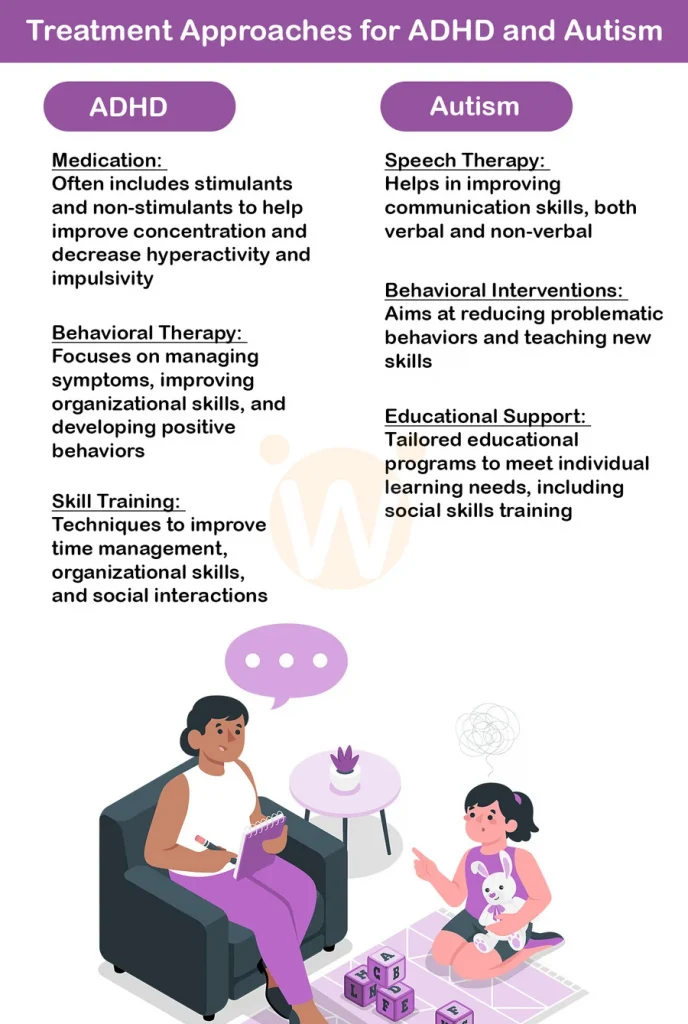
Outlining the Diagnosis Process:
Diagnosing ADHD and Autism involves a careful and detailed process. For ADHD, this may include assessments of attention, impulsivity, and hyperactivity. Autism diagnosis focuses on social communication and repetitive behaviors. In both cases, gathering comprehensive information from caregivers, teachers, and other relevant sources is vital.
Also Read: Navigating Parenting Challenges with Online Counselling
Treatment Modalities:
Treatment for ADHD often includes behavioral interventions, educational adjustments, and sometimes medication to manage symptoms like inattention or hyperactivity. In the case of Autism, therapies often focus on improving social skills and communication and reducing problematic behaviors. These treatments are most effective when tailored to the individual’s specific needs and circumstances.
ADHD and Autism: Diagnosis Criteria
| Criteria | ADHD | Autism |
|---|---|---|
| Age of Onset | Symptoms must be present before age 12 years. | Symptoms are generally recognized in the early developmental period, often before age 3. |
| Symptoms | – Inattention: Fails to give close attention to details, and has trouble holding attention on tasks or play activities. – Hyperactivity and Impulsivity: Fidgets, leaves seat, runs about or climbs in inappropriate situations, unable to play or engage in leisure activities quietly, “on the go” as if “driven by a motor.” | – Social Communication and Interaction: Deficits in social-emotional reciprocity, nonverbal communicative behaviors used for social interaction, and developing and maintaining relationships. – Restricted, Repetitive Patterns of Behavior: Stereotyped or repetitive speech, motor movements, insistence on sameness, inflexible adherence to routines, highly restricted, fixated interests. |
| Diagnostic Methods | – Clinical evaluation of behavior and attention. – Standardized rating scales. – Information from multiple settings (e.g., home, school). | – Comprehensive developmental history. – Behavioral observation. – Standardized diagnostic tools for ASD. |
Conclusion
These neurodevelopmental disorders, each unique in their own right, present a complex tapestry of challenges and strengths. ADHD, with its hallmark traits of inattention, hyperactivity, and impulsivity, affects individuals across various life stages. Autism, on the other hand, is characterized by its impact on social communication and behavior, with its spectrum nature underscoring the diversity of experiences among those affected.
Recognizing symptoms early on, seeking professional evaluation, and accessing appropriate interventions can make a significant difference in the lives of those with ADHD and Autism. At Wellness Hub, we are committed to this journey of understanding and support. We believe in a world where neurodiversity is not just acknowledged but celebrated. Our team of professionals is dedicated to providing guidance, resources, and care tailored to the needs of each individual and their families.
Frequently Asked Questions
1. What are the primary differences between ADHD and Autism?
ADHD (Attention Deficit Hyperactivity Disorder) primarily affects attention, impulsivity, and hyperactivity. Autism Spectrum Disorder (ASD), on the other hand, primarily impacts social communication and behavior, often including repetitive behaviors and restricted interests.
2. Can a person have both ADHD and Autism?
Yes, it’s possible for an individual to have both ADHD and Autism. This co-occurrence can complicate diagnosis and treatment, making comprehensive assessment and individualized care plans crucial.
3. What are the early signs of ADHD and Autism in children?
Early signs of ADHD include constant movement, impulsiveness, and difficulty focusing. For Autism, early signs may include delayed speech, limited eye contact, and repetitive behaviors.
4. How are ADHD and Autism diagnosed?
Diagnosis typically involves a comprehensive evaluation by healthcare professionals, which may include behavioral assessments, interviews, and observation. The process often involves gathering information from multiple sources, such as parents and teachers.
5. What treatment options are available for ADHD and Autism?
For ADHD, treatment options may include medication, behavioral therapy, and lifestyle changes. For Autism, interventions might focus on speech therapy, behavioral therapy, and educational support. Treatment is most effective when tailored to the individual’s specific needs.
6. Can adults be diagnosed with ADHD or Autism?
Yes, adults can be diagnosed with either condition. Some individuals may not receive a diagnosis until adulthood, especially in cases where symptoms are milder.
7. How can I support someone with ADHD or Autism?
Support can include understanding their needs, providing a structured and supportive environment, being patient, and encouraging their strengths. Professional guidance from experts at places like Wellness Hub can also be invaluable.
8. Are there any lifestyle changes that can help manage ADHD or Autism?
Yes, lifestyle changes such as regular physical activity, a healthy diet, consistent routines, and reducing sensory overload can be beneficial, especially when combined with other treatment modalities.
9. How can I learn more about ADHD and Autism?
You can learn more through reputable sources like healthcare providers, dedicated organizations, and educational resources like those provided by Wellness Hub. Staying informed and connected with supportive communities is also helpful.
10. Is it common for other conditions to coexist with ADHD or Autism?
Yes, it’s common for other conditions, such as anxiety, depression, and learning disabilities, to coexist with ADHD or Autism, highlighting the need for a holistic approach to treatment and support.
About the Author:
Rajini, Speech-Language Pathologist:
Rajini is a dedicated Speech-Language Pathologist with a focus on developmental speech and language disorders in children and rehabilitation in adults. With a passion for helping each individual find their voice, Rajini brings a wealth of experience and a heartfelt approach to therapy. At Wellness Hub, she’s part of a team that values innovation, compassion, and results-driven practices.
Book your Free Consultation Today
Parent/Caregiver Info:
Client’s Details:
* Error Message



